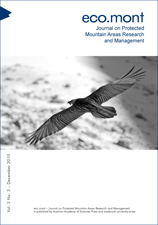Michael Duda,
Luise Kruckenhauser,
Elisabeth Haring,
Helmut Sattmann
S. 5 - 12
doi:
10.1553/eco.mont-2-2s5
Verlag der Österreichischen Akademie der Wissenschaften
doi:
10.1553/eco.mont-2-2s5
Abstract:
The habitat needs and potential threats to Trochulus oreinos oreinos (Wagner 1915) and Cylindrus obtusus (Draparnaud 1805) were assessed by comparing vegetation maps and our own records. We selected four sites from which we had adequate samples and for which exact vegetation maps were available: the mountains Hochschwab, Schneealpe, Rax and Schneeberg. Both taxa prefer open dry alpine grassland with diggable soil and/or stones. T. oreinos oreinos is restricted to subalpine and alpine boulder societies and Caricetum firmae. While C. obtusus dwells on several communities of plants, it seems to be bound to unconsolidated stony ground. As both taxa prefer naturally forest-free areas, they are not affected by structural changes of the habitat, such as reforestation caused by the abandonment of grazing and the shift of vegetation zones. But it has to be considered that T. oreinos oreinos and C. obtusus are limited by microclimatic factors, as they prefer cooler habitats. The mountains Schneealpe, Rax and Schneeberg, reaching barely 2 000 m in height, are on the climatic limit of the species distribution. Therefore, the investigated taxa are vulnerable to the upward shift of climate zones. T. oreinos oreinos shows striking similarities in its habitat preference to the Swiss endemic T. biconicus, as both taxa prefer the same dry alpine habitats which are quite different to those of other representatives of the genus, which prefer damp habitats.
Mollusca, Gastropoda, Cylindrus obtusus, Trochulus oreinos, habitat preferences, Alpine endemics, climate change
Published Online:
2010/11/24 14:52:20
Object Identifier:
0xc1aa5576 0x0024d22a
Rights:https://creativecommons.org/licenses/by-nc-nd/4.0/
The journal “eco.mont” – Journal of protected mountain areas research and management – was published for the first time in June 2009.
The journal was founded as a joint initiative of the Alpine Network of Protected Areas (ALPARC), the International Scientific Committee on Research in the Alps (ISCAR), the Austrian Academy of Sciences (ÖAW) and the University of Innsbruck.
The journal aims to highlight research on and management issues in protected areas in the Alps without excluding other protected mountain areas in Europe or overseas. Its target audiences are scientists from all related disciplines, managers of protected areas and interested individuals including practitioners, visitors, teachers, etc.
The journal presents peer-reviewed articles in English by authors who research protected mountain areas and management issues within these areas. It's published twice a year as a collaboration of the Austrian Academy of Sciences Press – responsible for the e-version – and Innsbruck University Press – responsible for the print version.
Die Zeitschrift „eco.mont“ – Zeitschrift zur Forschung in Gebirgsschutzgebieten – erschien im Juni 2009 zum ersten Mal. Die Zeitschrift wurde auf Initiative des Netzwerks Alpiner Schutzgebiete (ALPARC), der Schweizer Akademie der Naturwissenschaften (ISCAR), der Österreichischen Akademie für Wissenschaft (ÖAW) und der Universität Innsbruck gegründet. Sie hat das Ziel, Themen zu behandeln, die gleichzeitig Forschung und Verwaltung in und über die Schutzgebiete der Alpen betreffen, ohne dabei andere Gebirgsschutzgebiete Europas oder anderswo auszuschließen. Diese neue Zeitschrift richtet sich an ein Publikum von Wissenschaftlern der verschiedensten Fachbereiche, an die Verwalter von Schutzgebieten und an alle sonstigen Interessierten, Praktiker, Besucher, Lehrpersonal etc. einbegriffen. Die Zeitschrift veröffentlicht begutachtete Beiträge auf Englisch von Autoren, die Fragen der Gebirgsschutzgebieten und deren Verwaltung forschen. Sie erscheint zweimal pro Jahr, auf der Basis der gemeinsamen Anstrengungen des Verlags der Österreichischen Akademie der Wissenschaften, der für die digitale Fassung verantwortlich ist, und der Presse der Universität Innsbruck, verantwortlich für die gedruckte Fassung.



 Home
Home
 Print
Print
 References
References
 Share
Share

